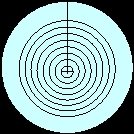The SART is a transceiver detectable by X-band radar, so that shipwrecked persons can be located by ships in the vicinity or by SAR forces.
Due to its characteristics, it is considered by many to be the best safety equipment after the EPIRB and it is in any case complementary to this, because rescuers have a better perception when approaching shipwrecks.
Once activated, the SART enters standby mode and when it detects a valid signal from an X-band radar, it starts transmitting, sending 12-pulse cycles.
Rescuers' radar identifies shipwrecked persons by means of a distinctive line consisting of 12 points when the SART is more than 5 miles away. When the ship approaches, the points are transformed into increasingly extended circle arcs, and then become concentric circles when the SART is within a radius of one mile.
The standards require a minimum battery life of 96 hours in standby and 8 hours in transmission. The SART must be tested once a month, using the test procedure with which each SART is equipped.


